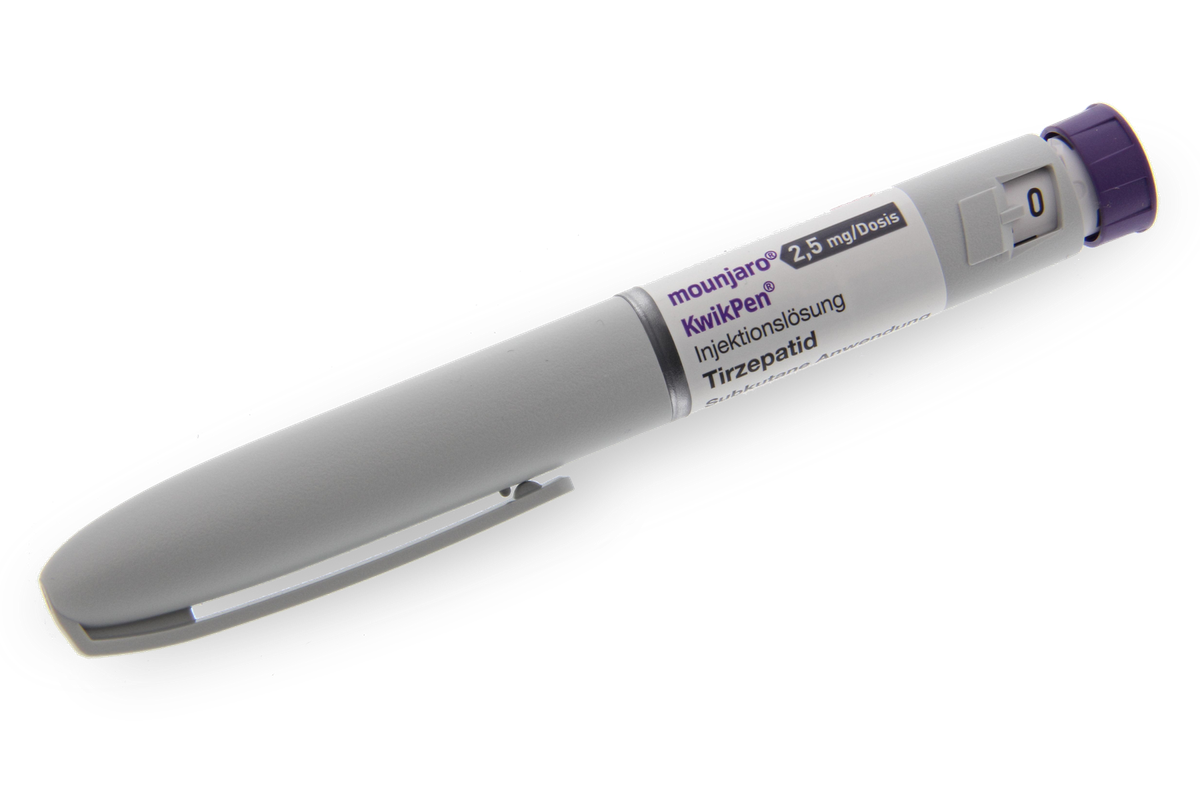
Mounjaro
- Suppresses your appetite and aids weight loss (on average up to 15% of body weight).
- Prefilled injection pen: each pen contains 4 doses and lasts for 4 weeks.
- Self-injection once a week: straightforward and safe to use with clear instructions.
How does Mounjaro help with weight loss?
Mounjaro is a prescription medicine that helps adults to lose weight. It contains the active ingredient tirzepatide, which reduces your appetite and helps you to feel full more quickly. This makes it easier to stick to a diet and supports weight loss.
About Mounjaro
Losing weight can be difficult, especially during menopause. Your metabolism slows down, and hormonal changes, tiredness, and changes in fat distribution also contribute. As a result, weight gain can occur more easily. Being overweight also increases the risk of menopausal symptoms, such as hot flushes.
Mounjaro was originally developed as a diabetes treatment, but it is also used for severe overweight and obesity. The product contains tirzepatide, which affects your sense of fullness. This reduces your appetite and makes it easier to lose weight.
The use of Mounjaro is always combined with a modified diet and sufficient physical activity.
Mounjaro is prescribed to adults with:
- Obesity: a BMI of 30 kg/m² or above.
- Overweight: a BMI between 27 and 30 kg/m², together with weight-related health problems, such as:
- type 2 diabetes;
- high blood pressure;
- raised blood lipid levels;
- sleep apnoea (breathing problems during sleep).
Use and effect of Mounjaro
Preparation and administration
Before you start, your doctor will show you how to use the pen. Detailed instructions are also provided in the package leaflet or in the user video.
Mounjaro is administered once a week by injection under the skin. The best sites are:
- the abdomen (at least 5 cm away from the navel);
- the thighs (front);
- the upper arms (possibly with assistance from someone else).
Use a different injection site each week. This helps to prevent bruising.
You can take Mounjaro at any time of day, with or without food. Select a set day that works for you and use the medication on the same day each week.
Stepwise dosing
Treatment begins with a low dose that is gradually increased to the recommended dose.
Schedule for adults:
- Week 1–4: 2.5 mg, once a week.
- From week 5: increase to 5 mg once a week.
- After that, the dose may be gradually increased up to a maximum of 15 mg once a week. You remain on the same dose for at least 4 weeks before your doctor advises an increase.
One pen lasts for 4 weeks. In the 3rd week – indicated by the plus sign (+) in the schedule – you should order a new pen. This ensures you can continue without interruption once the 4th week is over.
Note: this is the standard dosing schedule. Your doctor may prescribe a slightly different dose or schedule depending on your personal circumstances. Always follow your doctor's advice.

Used too much?
Have you used more Mounjaro than you should? Contact your doctor straight away or go to hospital. Possible symptoms include nausea, vomiting, or diarrhoea, which can lead to dehydration or low blood sugar (hypoglycaemia).
Missed dose
- Less than 4 days ago: administer the injection as soon as possible and then continue with your regular schedule.
- More than 4 days ago: skip the dose and continue according to your regular schedule.
- Never use a double dose to make up for a missed injection.
If you stop using Mounjaro
Do not stop using Mounjaro without discussing it with your doctor. Only a doctor can determine whether it is safe and appropriate to discontinue the treatment.
When Mounjaro should not be used
Do not use Mounjaro if you are allergic to tirzepatide or any of the other ingredients in this medicine (see package leaflet).
Be extra careful with Mounjaro
Always consult your doctor or pharmacist before starting Mounjaro. Use is not recommended if you:
- have severe stomach or bowel problems (such as gastroparesis);
- have previously had inflammation of the pancreas (pancreatitis);
- have eye problems, such as diabetic retinopathy;
- are using sulphonylureas or insulin in addition to Mounjaro (risk of hypoglycaemia).
During treatment, you may experience dehydration due to nausea, vomiting, or diarrhoea.
This is an overview of the main warnings. The package leaflet contains a complete overview of all precautions.
Use with other medicines
Always inform your doctor about any medicines you are taking, have taken, or are planning to take. Mounjaro can interact with certain medicines.
Driving and operating machinery
Mounjaro itself does not directly affect your ability to drive. If you use it together with insulin or sulphonylureas, low blood sugar (hypoglycaemia) may occur. This can affect your concentration. Do not drive or operate machinery if you experience this.
Side effects of Mounjaro
Not everyone experiences them, but some people do have side effects while using Mounjaro.
Serious side effects
- Sometimes (≤1 in 100 users): inflammation of the pancreas (acute pancreatitis). You can recognise this by severe, persistent abdominal pain that may radiate to the back. Consult a doctor immediately.
- Rarely (≤1 in 1,000 users): severe allergic reactions. Seek medical help immediately if you experience symptoms.
This list is not complete. A full overview of all serious side effects can be found in the package leaflet.
Other side effects
- Very common (≥1 in 10 users): nausea, diarrhoea, vomiting, constipation, and abdominal pain.
- Very common when used with insulin or sulphonylureas: low blood sugar (hypoglycaemia).
These symptoms mainly occur at the start of treatment and usually lessen over time. This list is not complete. A full overview of all side effects can be found in the package leaflet.
Do you experience side effects? Always contact your doctor or pharmacist. This also applies to possible symptoms not listed in the package leaflet.
Active ingredients and manufacturer
The active ingredient in Mounjaro is tirzepatide.
- Mounjaro 2.5 mg: each prefilled pen contains 2.5 mg tirzepatide in 0.5 ml solution (5 mg/ml).
- Mounjaro 5 mg: each prefilled pen contains 5 mg tirzepatide in 0.5 ml solution (10 mg/ml).
- Mounjaro 7.5 mg: each prefilled pen contains 7.5 mg tirzepatide in 0.5 ml solution (15 mg/ml).
- Mounjaro 10 mg: each prefilled pen contains 10 mg tirzepatide in 0.5 ml solution (20 mg/ml).
- Mounjaro 12.5 mg: each prefilled pen contains 12.5 mg tirzepatide in 0.5 ml solution (25 mg/ml).
- Mounjaro 15 mg: each prefilled pen contains 15 mg tirzepatide in 0.5 ml solution (30 mg/ml).
The other ingredients in this product are disodium hydrogen phosphate heptahydrate (E339), sodium chloride, sodium hydroxide, concentrated hydrochloric acid, and water for injections.
Manufacturer
Eli Lilly Nederland B.V.
Papendorpseweg 83
3528 BJ Utrecht
Netherlands
Mounjaro with a prescription in the United Kingdom
Mounjaro is only available in the United Kingdom with a prescription. During an online consultation, a doctor will determine whether this medication is appropriate for you. If the doctor provides a prescription, it will be sent directly to a partner pharmacy.
The cost of the consultation is included in the price of Mounjaro.
Package leaflet










